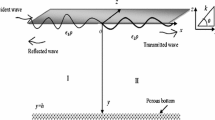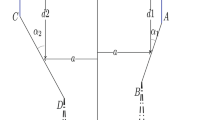Abstract
An integral equation method is developed to study the wave interaction with two symmetric permeable plates submerged in a two-layer fluid. The plates are inclined and penetrate the common interface between the layers. The existence of two different wave modes for the incident wave gives rise to two problems. Both of these are tackled by reducing them to a set of coupled hypersingular integral equations of the second kind. Unknown functions of the integral equations are the discontinuities in the potential functions across portions of the plates. These are computed numerically by employing an expansion collocation method. New results for the reflection coefficients and the amount of energy loss are presented by varying several parameters such as porosity, angle of inclination, plate-length, separation between the plates, interface position and density ratio. Known results for two symmetric vertical permeable and impermeable plates, single vertical impermeable and horizontal permeable plates are recovered from the present analysis.
























Similar content being viewed by others
References
Sollitt CK, Cross RH (1973) Wave transmission through permeable breakwaters. Coast Eng 20:1827–1846
Tuck EO (1975) Matching problems involving flow through small holes. Adv Appl Mech 15:89–158
Macaskill C (1979) Reflexion of water waves by a permeable barrier. J Fluid Mech 95(1):141–157
Yu X (1995) Diffraction of water waves by porous breakwaters. J Waterw Port Coast Ocean Eng 121(6):275–282
Isaacson M, Baldwin J, Premasiri S, Yang G (1999) Wave interactions with double slotted barriers. Appl Ocean Res 21(2):81–91
Dalrymple RA, Losada MA, Martin PA (1991) Reflection and transmission from porous structures under oblique wave attack. J Fluid Mech 224:625–644
Evans DV, Peter MA (2011) Asymptotic reflection of linear water waves by submerged horizontal porous plates. J Eng Math 69(2–3):135–154
McIver P (2005) Diffraction of water waves by a segmented permeable breakwater. J Waterw Port Coast Ocean Eng 131(2):69–76
Gayen R, Mondal A (2014) A hypersingular integral equation approach to the porous plate problem. Appl Ocean Res 46:70–78
Mondal D, Banerjea S (2016) Scattering of water waves by an inclined porous plate submerged in ocean with ice cover. Q J Mech Appl Mech 69(2):195–213
Behera H, Kaligatla RB, Sahoo T (2015) Wave trapping by porous barrier in the presence of step type bottom. Wave Motion 57:219–230
Behera H, Gayathri R, Selvan SA (2019) Wave attenuation by multiple outer porous barriers in the presence of an inner rigid cylinder. J Waterw Port Coast Ocean Eng 146(1):04019035
Gupta S, Gayen R (2018) Scattering of oblique water waves by two thin unequal barriers with non-uniform permeability. J Eng Math 112(1):37–61
Gupta S, Gayen R (2019) Water wave interaction with dual asymmetric non-uniform permeable plates using integral equations. Appl Math Comput 346:436–451
Linton CM, McIver M (1995) The interaction of waves with horizontal cylinders in two-layer fluids. J Fluid Mech 304:213–229
Cadby JR, Linton CM (2000) Three-dimensional water-wave scattering in two-layer fluids. J Fluid Mech 423:155–173
Linton CM, Cadby JR (2002) Scattering of oblique waves in a two-layer fluid. J Fluid Mech 461:343–364
Ten I, Kashiwagi M (2004) Hydrodynamics of a body floating in a two-layer fluid of finite depth. Part 1. Radiation problem. J Mar Sci Technol 9(3):127–141
Sherief HH, Faltas MS, Saad EI (2004) Axisymmetric gravity waves in two-layered fluids with the upper fluid having a free surface. Wave Motion 40(2):143–161
Chamberlain PG, Porter D (2005) Wave scattering in a two-layer fluid of varying depth. J Fluid Mech 524:207–228
Kashiwagi M, Ten I, Yasunaga M (2006) Hydrodynamics of a body floating in a two-layer fluid of finite depth. Part 2. Diffraction problem and wave-induced motions. J Mar Sci Technol 11(3):150–164
Nazarov SA, Videman JH (2009) A sufficient condition for the existence of trapped modes for oblique waves in a two-layer fluid. Proc R Soc A Math Phys Eng Sci 465(2112):3799–3816
Das D, Mandal BN (2010) Wave radiation by a sphere submerged in a two-layer ocean with an ice-cover. Appl Ocean Res 32(3):358–366
Behera H, Sahoo T (2014) Gravity wave interaction with porous structures in two-layer fluid. J Eng Math 87(1):73–97
Paul S, De S (2017) Wave scattering by uneven porous bottom in a three layered channel. J Mar Sci Technol 22(3):533–545
Lin Q, Du XG, Kuang J, Song HF (2019) Forces and moments exerted by incident internal waves on a plate-cylinder structure in a two-layer fluid. Meccanica 54(10):1545–1560
Levine H, Rodemich E (1958) Scattering of surface waves on an ideal fluid. Technical report, Stanford Univ. Ca. Applied Mathematics and Statistics labs
Jarvis RJ (1971) The scattering of surface waves by two vertical plane barriers. J Inst Maths Appl 7:207–215
Newman JN (1974) Interaction of water waves with two closely spaced vertical obstacles. J Fluid Mech 66(1):97–106
Das P, Dolai DP, Mandal BN (1997) Oblique wave diffraction by parallel thin vertical barriers with gaps. J Waterw Port Coast Ocean Eng 123(4):163–171
Roy R, Mandal BN (2018) Water wave scattering by three thin vertical barriers with middle one partially immersed and outer two submerged. Meccanica 20:1–14
Mondal A, Gayen R (2015) Wave interaction with dual circular porous plates. J Mar Sci Appl 14(4):366–375
Karmakar D, Soares CG (2014) Wave transformation due to multiple bottom-standing porous barriers. Ocean Eng 80:50–63
Behera H, Ng CO (2018) Interaction between oblique waves and multiple bottom-standing flexible porous barriers near a rigid wall. Meccanica 53(4–5):871–885
Shen YM, Zheng YH, Ng CO (2007) Interaction of oblique waves with an array of long horizontal circular cylinders. Sci China Ser E Technol Sci 50(4):490–509
Das BC, De S, Mandal BN (2018) Oblique scattering by thin vertical barriers in deep water: solution by multi-term galerkin technique using simple polynomials as basis. J Mar Sci Technol 23(4):915–925
Gayen R, Mandal BN, Chakrabarti A (2005) Water-wave scattering by an ice-strip. J Eng Math 53(1):21–37
Gayen R, Mandal BN, Chakrabarti A (2006) Water wave scattering by two sharp discontinuities in the surface boundary conditions. IMA J Appl Math 71(6):811–831
Gayen R, Mandal BN, Chakrabarti A (2007) Water wave diffraction by a surface strip. J Fluid Mech 571:419–438
Gayen R, Mandal BN (2009) Scattering of surface water waves by a floating elastic plate in two dimensions. SIAM J Appl Math 69(6):1520–1541
Porter R, Porter D (2000) Water wave scattering by a step of arbitrary profile. J Fluid Mech 411:131–164
Porter R, Evans DV (2007) Diffraction of flexural waves by finite straight cracks in an elastic sheet over water. J Fluids Struct 23(2):309–327
Dhillon H, Banerjea S, Mandal BN (2014) Wave scattering by a thin vertical barrier in a two-layer fluid. Int J Eng Sci 78:73–88
Islam N, Gayen R (2018) Scattering of water waves by an inclined plate in a two-layer fluid. Appl Ocean Res 80:136–147
Yu X, Chwang AT (1994) Wave motion through porous structures. J Eng Mech 120(5):989–1008
Parsons NF, Martin PA (1994) Scattering of water waves by submerged curved plates and by surface-piercing flat plates. Appl Ocean Res 16(3):129–139
Porter R, Evans DV (1995) Complementary approximations to wave scattering by vertical barriers. J Fluid Mech 294:155–180
Cho IH, Kim MH (2013) Transmission of oblique incident waves by a submerged horizontal porous plate. Ocean Eng 61:56–65
Kumar PS, Oh YM, Cho WC (2008) Surface and internal waves scattering by partial barriers in a two-layer fluid. J Korean Soc Coast Ocean Eng 20(1):25–33
Acknowledgements
The authors are thankful to the reviewers for their constructive suggestions to revise the paper.
Author information
Authors and Affiliations
Corresponding author
Additional information
Publisher's Note
Springer Nature remains neutral with regard to jurisdictional claims in published maps and institutional affiliations.
Appendices
Appendix 1
The expressions of the Green’s functions \({\mathcal {G}}^{(i)}_j(x_i,z_i;\xi _j,\eta _j)\) are given in this Appendix as follows:
where \({\mathcal {P}}^{(1)}_1={\mathcal {P}}^{(1)}_2={\mathcal {P}}^{(2)}_2=1\), \({\mathcal {P}}^{(2)}_1=\rho \), \({\mathcal {Q}}^{(1)}_1={\mathcal {Q}}^{(1)}_2=1\), \({\mathcal {Q}}^{(2)}_1={\mathcal {Q}}^{(2)}_2=\rho \), \({\mathcal {R}}^{(1)}_1={\mathcal {R}}^{(2)}_1={\mathcal {R}}^{(2)}_1=0\), \({\mathcal {R}}^{(2)}_2=1-\rho \), \(r,r_2=\sqrt{(x_i-\xi _j)^2+(z_i\mp \eta _j)}, r_1=\sqrt{(x_i-\xi _j)^2+(2h+z_i+\eta _j)^2}\),
Our analysis may be restricted to the region \(x\ge 0\) only due to the geometrical symmetry of the two plates about the z-axis. When the source point is in the upper layer, we first apply Green’s integral theorem to the functions \({\mathcal {G}}^{(1)S,A}_1(x_1,z_1;\xi _1,\eta _1)={\mathcal {G}}^{(1)}_1(x_1,z_1;\xi _1,\eta _1)\pm {\mathcal {G}}^{(1)}_1(-x_1,z_1;\xi _1,\eta _1)\) and the scattered velocity potentials \({\widehat{\varphi }}^{(1)S,A}_n=\varphi ^{(1)S,A}(x_1,z_1)-f^{(1)}_n(z_1){\text {e}}^{-\text {i}M_n(x_1-a)}\) in the region bounded by the lines \(z_1=-h,0 (0\le x_1\le X); x_1=0,X (-h\le z_1\le 0);\) a small circle of radius \(\varepsilon \) with center at \((\xi _1,\eta _1)\) and a contour enclosing the arc \(L_1\), and ultimately we make \(X\rightarrow \infty , \varepsilon \rightarrow 0\) and shrink the contour enclosing \(L_1\) in the two sides of \(L_1\). Using conditions 2 and 10, we obtain
Again we apply Green’s integral theorem to the functions \({\mathcal {G}}^{(2)S,A}_1(x_2,z_2;\xi _1,\eta _1)={\mathcal {G}}^{(2)}_1(x_2,z_2;\xi _1,\eta _1)\pm {\mathcal {G}}^{(2)}_1(-x_2,z_2;\xi _1,\eta _1)\) and the scattered velocity potentials \({\widehat{\varphi }}^{(2)S,A}_n=\varphi ^{(2)S,A}(x_2,z_2)-f^{(2)}_n(z_2){\text {e}}^{-\text {i}M_n(x_2-a)}\) in the region bounded by the lines \(z_2=0,H (0\le x_2\le X); x_2=0,X (0\le z_2\le H);\) and a contour enclosing the arc \(L_2\), and ultimately we make \(X\rightarrow \infty ,\) and shrink the contour enclosing \(L_2\) in the two sides of \(L_2\). Using conditions 5 and 10, we obtain
Multiplying Eq. 41 by \(\rho \) and adding to Eq. 42 and using the interface conditions we find
Thus, the above equation simplifies to
Next, we consider the case when the source point is in the lower layer. Following a similar procedure as described above, we obtain
Appendix 2
The functions \({\mathcal {H}}^{(i)S,A}_j(t,s)\) given in 23 are computed by taking repeated normal derivatives of \({\mathcal {G}}^{(i)S,A}_{j}(q_i:p_j)\). The final explicit expression of \({\mathcal {H}}^{(i)S,A}_j(t,s)\) are
The various quantities appearing in 45 are given by \(\lambda ^{(1)}_{1}=\lambda ^{(2)}_{2}=0\),\(\lambda ^{(2)}_{1}=\lambda ^{(1)}_{2}=1\),\(A^{(1)}_{1}=A^{(1)}_{2}=1,A^{(2)}_{1}=A^{(2)}_{2}=\rho \),\(B^{(1)}_{1}=B^{(1)}_{2}=B^{(2)}_{1}=0,B^{(2)}_{2}=1-\rho \), \(X^{(i)}_j=x_i-\xi _j\), \(Z^{(i)}_j=z_i+\eta _j\), \(X^{(i)}_{1j}=x_i+\xi _j\), \(Z^{(i)}_{1j}=z_i-\eta _j\), \(C^{(i)}_{j}(u;z_i,\eta _j)=\cos ^2\theta g^{(i)}_{j}(u;z_i,\eta _j)+\sin ^2\theta \frac{1}{u^2}\frac{\partial ^{2}g^{(i)}_{j}}{\partial z_i\partial \eta _j}(u;z_i,\eta _j)\), \(D^{(i)}_{j}(u;z_i,\eta _j)=\cos \theta \sin \theta \{ -\frac{1}{u}\frac{\partial g^{(i)}_{j}}{\partial \eta _j}(u;z_i,\eta _j)+\frac{1}{u}\frac{\partial g^{(i)}_{j}}{\partial z_i}(u;z_i,\eta _j)\}\), \(E^{(i)}_{j}(u;z_i,\eta _j)=-\cos ^2\theta g^{(i)}_{j}(u;z_i,\eta _j)+\sin ^2\theta \frac{1}{u^2}\frac{\partial ^{2}g^{(i)}_{j}}{\partial z_i\partial \eta _j}(u;z_i,\eta _j)\), \(F^{(i)}_{j}(u;z_i,\eta _j)=\cos \theta \sin \theta \{ -\frac{1}{u}\frac{\partial g^{(i)}_{j}}{\partial \eta _j}(u;z_i,\eta _j)-\frac{1}{u}\frac{\partial g^{(i)}_{j}}{\partial z_i}(u;z_i,\eta _j)\}\).
About this article
Cite this article
Islam, N., Gayen, R. Water wave scattering and energy dissipation by interface-piercing porous plates. J Mar Sci Technol 26, 108–127 (2021). https://doi.org/10.1007/s00773-020-00725-6
Received:
Accepted:
Published:
Issue Date:
DOI: https://doi.org/10.1007/s00773-020-00725-6




